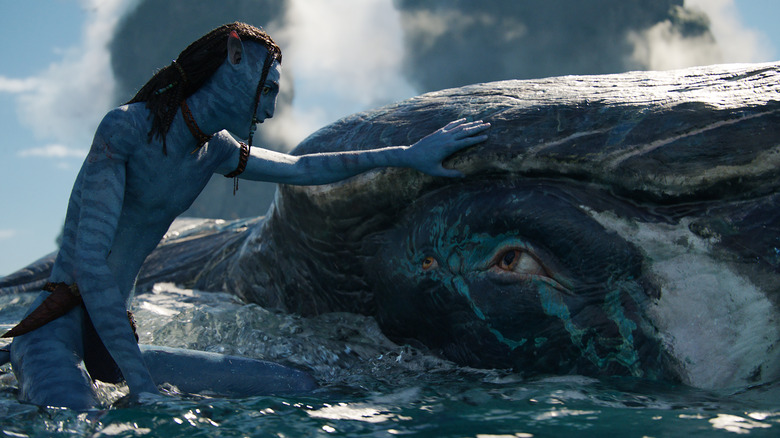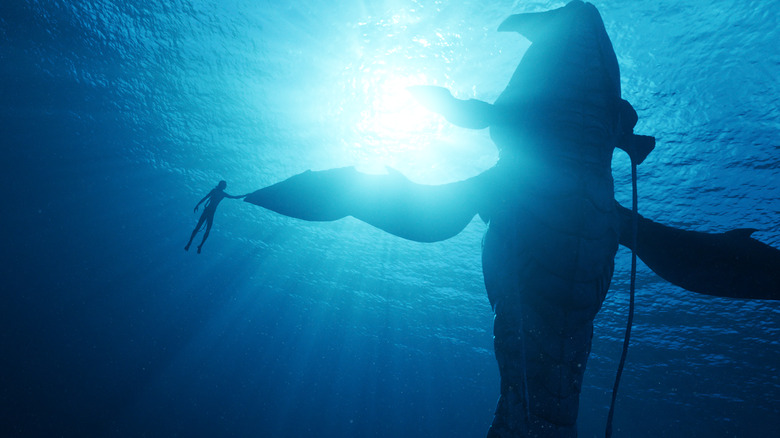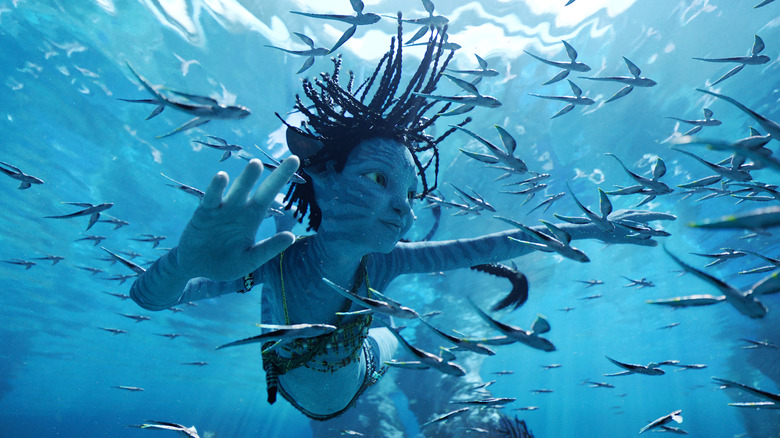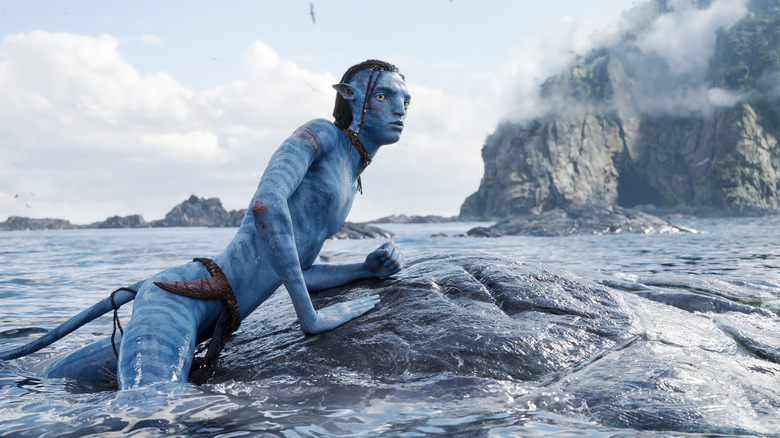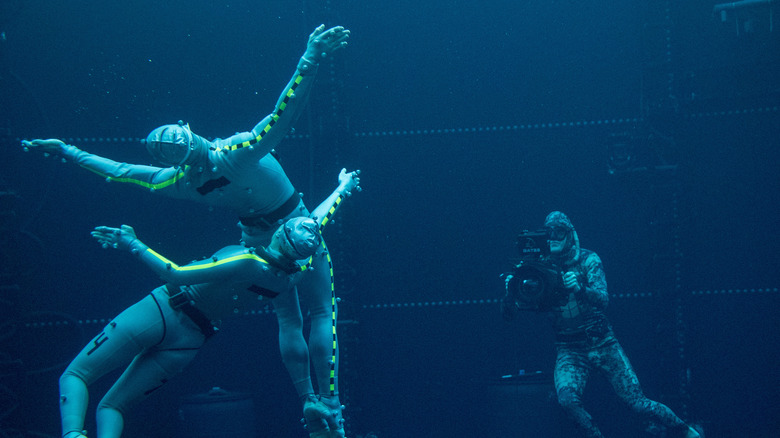Avatar: The Way Of Water's Biggest VFX Challenges Were Not The Usual 'Third Act Battles'
Visual effects have been around since the early days of the silent era, when filmmakers like Georges Méliès used stage magic tricks and early photographic and editing experiments to make characters appear from out of nowhere, float on-screen, or travel to other planetoids and meet bizarre alien life forms. And while in many respects nothing has changed — we're still making movies packed with visual effects to trick audiences into thinking they're watching something real — the technology we use to create these illusions has evolved so rapidly that even Monsieur Méliès would probably have no idea how a film like "Avatar: The Way of Water" pulled off its incredible images.
Even the visual effects artists who worked on "Avatar: The Way of Water" were faced with highly unusual challenges. This wasn't the usual sci-fi spectacular, where villains shoot skybeams into the air while costumed do-gooders and do-badders hold their hands out and shoot CGI energy bolts at one another. The effects in "The Way of Water" were recreating a complex real-life substance with details down to the millimeter, and if it was not accurately recreated in the computer, the audience would know, because we all know what water looks like.
New film, new environments
At a press conference with producer Jon Landau and key visual effects team members at Weta Workshop — the New Zealand company with credits on "The Lord of the Rings," "Avatar," "Alita: Battle Angel," and "Dune" — senior VFX supervisor Joe Letteri explained how their work is always about the story.
"The fact that [James Cameron] decided to take it to another part of Pandora, like, there's a whole world out here that we haven't explored," Letteri said, referring to the new film's plot, which sends Jake Sully, Neytiri, and their children to an island locale. "And I remember talking to him about that, and he said, 'Every movie on Earth happens in some place on Earth, and you still get stories out of it.'"
There is a strange tendency in sci-fi storytelling to typify an entire planet based on one look or ecosystem, even though the planet we all live on — Earth, unless your wi-fi on another planet is exceptional — features a wide variety of locations with different weather, environments, and artificial structures built for different purposes and different styles. Pandora, it seems, is no different, and that forced Letteri to come up with new aesthetics for "Avatar: The Way of Water."
"The fact that we were taking this to this new village with these new characters and this new environment, I was thinking more about the overall scope of what that could look like," Letteri explained. "And then, of course, from there, you start to delve into the technical challenges that you have to build for. But really the overall feeling was just really a nice setup."
Slippery when wet
Any new environment would have posed distinct challenges to the VFX team at Weta, but James Cameron's decision to build the majority of "Avatar: The Way of Water" around an aquatic story — one in which almost all the characters would spend significant amounts of time getting in and out of the oceans of Pandora — made it trickier than usual.
"It takes a very large team of really talented effects TDs [technical directors] to really look at not only their own simulations, but how those simulations work at all different scales," explained Johnathan Nixon, the head of Weta's simulation tools for water and fire FX.
Nixon was responsible for scenes where characters and other creatures emerge from the oceans on Pandora, and all the subtle and not-so-subtle water effects that stem from those actions. We may take the way water responds when we splash around in it for granted in real life, but getting those effects out of a computer is significantly more complicated, even when characters aren't trying to kill each other. When the characters are just sitting in the water having a conversation, Nixon explained how his team still had plenty of work to do, such as making sure that the water running off their face looked right, and that little details like how any fingers on the water create capillary waves on it, looked believable.
Different kinds of battles
Johnathan Nixon may have been used to working on CGI-heavy action movies, but "Avatar: The Way of Water" wasn't like the others.
"Generally, where you're used to working on big third-act battles and you get one big sequence as an effects artist to go, 'Great. I'm gonna do a bunch of really awesome sims,' but this film had sims everywhere and specifically for water. And trying to make sure you get all the transitions and the feelings, it's not just your free surface," Nixon explained. "It's what happens when a character goes underneath the water. What happens when the character then breaches? What are all the different states and the changes that happen at that time?"
Nixon conceded with a laugh that doing all this was a challenge. "But it was a challenge that our team took on pretty excitedly," he added. "You don't get a chance to work on a film like this where, as an effects artist, you have your fingerprint all over it. And I think our team really took to the challenge and did an excellent job."
There's something funny, however, about the way of water — by which I mean actual water, not Pandora water, with all its plot points and subtextual themes. You can film actors in mo-cap suits swimming in the real thing, but that doesn't necessarily solve your problems with recreating all that water in post.
The other way of water
As Jon Landau pointed out, scenes with live-action actors getting into live-action water actually made Johnathan Nixon's job more complicated. "We know exactly what that looks like because we filmed it, sometimes up to 40 takes on it to get to the right thing" Landau laughed. "And you had to match into that."
"You can't match move water, not yet," Nixon added, referencing the ability to move CG elements into images relative to the other elements in the shot. "We're close, but not yet. [...] A lot of it was looking at the stage performance, looking at the capture, and trying to get the spirit of what was captured on stage and realizing [the] animations changed a little bit or [a] hand is moved to tell the story a little bit better. And we need to adapt to that, but still keep the same feeling of what happened on stage."
In other words, although the live-action performers and their movements are captured in real water, the water still needs to be added in post, and any changes the VFX animators make to the actors' performances will have a major effect on the way those characters interact with the water.
But as Nixon points out, just like Letteri's team had to find the spirit of the new environments on Pandora, Nixon's water effects group had to "match the spirit of that [real on-set water] while still adding to the realism and the character of the water itself."
So the next time you watch "Avatar: The Way of Water," remember that every drop of that water was meticulously crafted, and it wasn't easy to make it look real for you.
